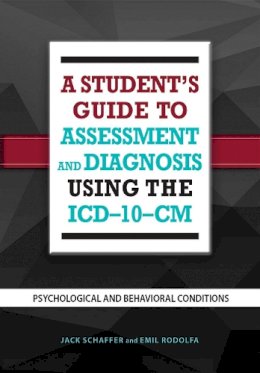
Stock image for illustration purposes only - book cover, edition or condition may vary.
Student's Guide to Assessment and Diagnosis Using the ICD-10-CM
Schaffer, Jackie; Rodolfa, Emil R.
€ 59.94
FREE Delivery in Ireland
Description for Student's Guide to Assessment and Diagnosis Using the ICD-10-CM
Paperback. In the United States, psychologists are in the process of adapting to the World Health Organization's International Classification of Diseases (ICD). This easy-to-read guide - optimized for implementation in the classroom - teaches students a straightforward conceptual framework for assessment and diagnosis with the ICD-10-CM as its foundation. Series: Applications of ICD-10 and ICD-11 to Psychology. Num Pages: 224 pages. BIC Classification: JMP; MMJ. Category: (G) General (US: Trade). Dimension: 229 x 152 x 5. Weight in Grams: 431.
This book provides graduate students and psychology interns with a conceptual framework for diagnosis and assessment using the ICD- -CM. Using three detailed case examples, it teaches fundamental critical thinking skills that are essential in real-life clinical scenarios.
In the United States, psychologists find themselves having to adapt to the World Health Organization amp rsquo s International Classification of Diseases (ICD), the th edition of which was recently integrated-with clinical modifications (ICD- -CM)-into the U.S. healthcare system. This transition also affects graduate students, interns, and trainees in psychology who are just learning the basics of assessment and diagnosis, as well as their instructors who are themselves adjusting to this new diagnostic system.
This easy-to-read guide-optimized for implementation in the classroom-teaches students a straightforward conceptual framework for assessment and diagnosis with the ICD- -CM at its foundation. The authors begin with a brief primer on the ICD- -CM, demonstrating how to interpret diagnostic codes and use them as guides for critical thinking. Common challenges, errors, and biases involved with assessing clients and making diagnoses are also discussed.
The core of the book revolves around three detailed case examples, each one given special attention in its own chapter. These examples follow common yet very different clinical scenarios. They demonstrate how to collect and interpret data to formulate possible diagnoses. Potential ethical and risk management issues are examined, as are considerations for developing an intervention plan. The book ends with review of other key resources related to assessment, diagnosis, and the ICD- -CM.
In the United States, psychologists find themselves having to adapt to the World Health Organization amp rsquo s International Classification of Diseases (ICD), the th edition of which was recently integrated-with clinical modifications (ICD- -CM)-into the U.S. healthcare system. This transition also affects graduate students, interns, and trainees in psychology who are just learning the basics of assessment and diagnosis, as well as their instructors who are themselves adjusting to this new diagnostic system.
This easy-to-read guide-optimized for implementation in the classroom-teaches students a straightforward conceptual framework for assessment and diagnosis with the ICD- -CM at its foundation. The authors begin with a brief primer on the ICD- -CM, demonstrating how to interpret diagnostic codes and use them as guides for critical thinking. Common challenges, errors, and biases involved with assessing clients and making diagnoses are also discussed.
The core of the book revolves around three detailed case examples, each one given special attention in its own chapter. These examples follow common yet very different clinical scenarios. They demonstrate how to collect and interpret data to formulate possible diagnoses. Potential ethical and risk management issues are examined, as are considerations for developing an intervention plan. The book ends with review of other key resources related to assessment, diagnosis, and the ICD- -CM.
Product Details
Format
Paperback
Publication date
2015
Publisher
American Psychological Association United States
Number of pages
224
Condition
New
Series
Applications of ICD-10 and ICD-11 to Psychology
Number of Pages
225
Place of Publication
Washington DC, United States
ISBN
9781433820939
SKU
V9781433820939
Shipping Time
Usually ships in 7 to 11 working days
Ref
99-1
About Schaffer, Jackie; Rodolfa, Emil R.
Jack Schaffer, PhD, spent 7 years in independent practice and years as faculty in two medical schools and a professional school. His private practice specialized in clinical and neuropsychological assessments and psychotherapy with adults and families. He received his doctorate in clinical psychology from The University of North Dakota and is certified by the American Board of Professional Psychology in clinical psychology and clinical health psychology. He is a fellow and past president of the Association of State and Provincial Psychology Boards and a past chair of the State of Minnesota Board of Psychology. He currently serves on APA's Commission on Accreditation. Dr. Schaffer's professional interests include psychological assessment, defining and assessing professional competence, and ethical and legal issues. He enjoys woodworking, bicycling, and spending time with his wife, his two children, and four grandchildren. Emil Rodolfa, PhD, is a professor of psychology at Alliant International University's California School of Professional Psychology (CSPP) in Sacramento. He received his doctorate from Texas A amp M University and was training director and director of the University of California Counseling and Psychological Services prior to joining the faculty at CSPP. He is the founding editor of Training and Education in Professional Psychology and was Associate Editor of Professional Psychology: Research and Practice. Dr. Rodolfa is a fellow of APA, a fellow and past president of the Association of State and Provincial Psychology Boards, a Board Member Emeritus and past chair of the Association of Psychology Postdoctoral and Internship Centers, and a past president of the State of California Board of Psychology. His professional interests include defining and assessing professional competence, ethical and legal issues, supervision and training, college student mental health, and the assessment and treatment of anxiety and depression. He enjoys spending time with his family, playing horseshoes and BBQing (some might call it grilling) at his cabin in the mountains.
Reviews for Student's Guide to Assessment and Diagnosis Using the ICD-10-CM
